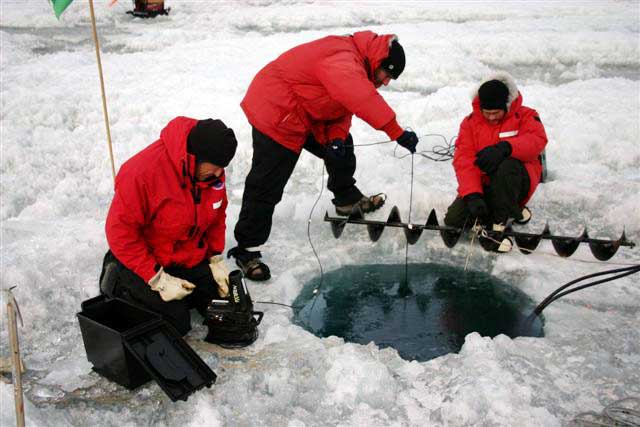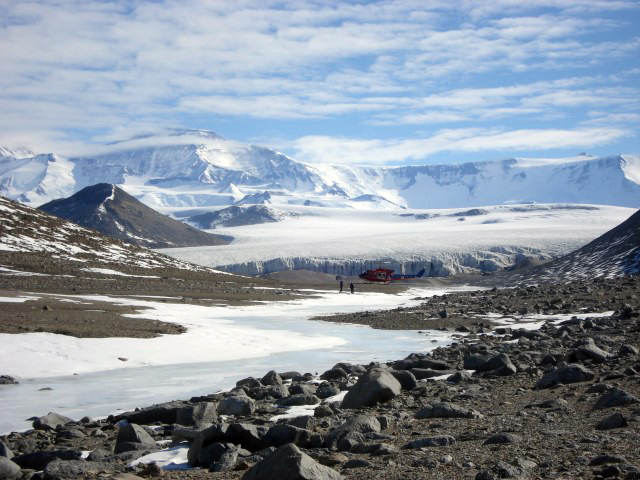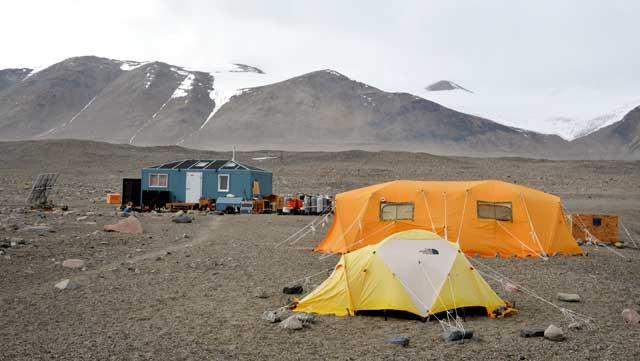|
Page 3/3 - Posted September 27, 2013
ReconnectingHowever, the past can provide clues about the future.
A super lake dubbed Lake Washburn once filled Taylor Valley thousands of years ago. Now researchers believe the lakes are again slowly beginning to merge. Lake Bonney alone has risen about 15 meters since Scott made a record of his visit in 1903.
“They’re roughly changing together, although Lake Bonney, because of its steep sides and water input from the Taylor Glacier, is rising the fastest,” says John Priscu

Photo Courtesy: John Priscu/Antarctic Photo Library
Scientists John Priscu, Phil Lee and Mike Lizotte use an underwater camera to check the progress of a hole being melted on Lake Bonney during the 2007-08 field season
A professor of ecology at Montana State University
In 100 years, Lake Fryxell would merge with Lake Hoare. In two centuries, Lake Bonney would flow east and coalesce with Fryxell and Hoare. In less than a millennium, the lake would fill the valley and drain into McMurdo Sound.
“When they start merging again, the biodiversity is going to smear out,” Priscu said during an interview in 2011-12. “We’re going to lose these unique organisms.”
More immediately, the researchers stand to lose the semi-permanent field camps that sit along the shores of the Taylor Valley lakes.
A field camp built in 1988 on the shores of Lake Bonney is already being moved to higher ground until a new facility is constructed. A new camp is also planned at the Lake Fryxell camp, which is similarly being threatened by higher water levels. The stream team base at a camp dubbed F6 on the opposite shore of Lake Fryxell is safe for now. [See previous article — Flooded Out: Rising lake levels in the McMurdo Dry Valleys affect science, field camps.]
New Territory
Photo Credit: Tyler Kohler/Antarctic Photo LIbrary
The McMurdo LTER team conducts reconnaissance on the Garwood River in the Garwood Valley. The LTER program is expanding its research area to include Garwood and Miers valleys.
It’s not just the lakes that are spreading out.
For the current McMurdo LTER funding cycle – based on six years versus the typical three-year grant – the researchers have taken their study farther south to the Miers and Garwood valleys. For the most part, the McMurdo LTER has been confined mainly to Taylor and Wright valleys until now.
“Each valley is different,” Wall notes.
Garwood Valley, for instance, is relatively small, with a single stream that twice disappears from the surface as it courses toward the sea. It flows below the Garwood Glacier and then underneath a dune of dirt. Miers Valley, on the other hand, contains an open-basin lake that drains to the sea, which influences the chemistry of the lake water.
“If we really want to make a good statement that warming is occurring on a regional level, we need to have long-term data from a couple of other places,” Wall says.
The additional workload means that some observations and experiments will have to drop off, as projects like P3 come online. McKnight says the use of telemetry at stream gauges, with data transmitted from sites rather than being visited manually, will also help the McMurdo LTER enlarge its footprint into the other valleys without adding staff.
“You can’t do it all remotely and not show up for a year, but we’re hoping we can be more efficient,” McKnight says.
New Blood and Old TiesThe McMurdo LTER added some new faces to the roster of principal investigators for the current grant cycle, including Barrett and hydrologist Michael Gooseff at CSU, who first worked on the program as a graduate student. Environmental historian Adrian Howkins, also at CSU, adds a social sciences angle to the McMurdo LTER. [See previoius article — Historical Context: McMurdo LTER adds social sciences to research program.]

Photo Credit: Elaine Hood/Antarctic Photo Library
Ruth Heindel, graduate student at Dartmouth College, measures the pH of a soil sample collected from the McMurdo Dry Valleys at McMurdo Station's Crary Lab.
In fact, dozens of students have trained through the McMurdo LTER over the years. Some have worked on the Ice for a single season, while others have turned the experience into a lifetime career in polar science.
“To bring a student down to a place like this is just amazing,” Virginia says. “It’s that really close relationship that you get down here with students that you don’t necessarily get at the university. … I think all of us really enjoy bringing students down here.”
Connectivity within the McMurdo Dry Valleys is reflected in the collaboration among the scientists, according to Virginia.
“One of the strengths of the LTER and one of the reasons that long-term research is so invaluable is that you cultivate that cross-discipline [nature],” he says. “We learn from one another. That’s really hard to do on those short grant cycles.”
McKnight adds, “The interactions have gotten stronger and stronger. … It’s really a privilege to be the leader of this group. There are a lot of people carrying the weight of different aspects of the project.”
NSF-funded research in this article: Diane McKnight, University of Colorado-Boulder, Award No. 1115245
|



For USAP Participants |
For The Public |
For Researchers and EducatorsContact UsNational Science FoundationOffice of Polar Programs Geosciences Directorate 2415 Eisenhower Avenue, Suite W7100 Alexandria, VA 22314 Sign up for the NSF Office of Polar Programs newsletter and events. Feedback Form |


